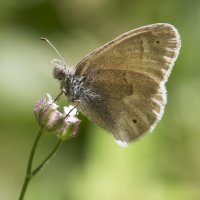I do a lot of macro with small critters, particularly insects, and I've been pushing this on the forum for years. Others who do critter macro work have suggested similar things. So apparently Canon continues to listen to their customer base.
With insects, more light is a huge help as I typically work handheld. The difference in DOF from f/2.8 is less of a problem than one might think, and you still have the option of stopping down. But the chief difficulty is that magnification makes motion and vibration much, much worse. Obtaining twice the light means halving the shutter speed, and that is often the difference between a keeper and a tosser in this work. [See attached example, 1/250s @ f/6.3 w/ 180mm L Macro handheld while near the ground cantilevered over mud. This won't work at 1/125s.]
View attachment 190680
The main difficulty with such a lens design is weight. Most people who don't do macro seriously won't lift weights, something I generally recommend to folks who want to use a 180mm+ macro lenses as holding one steadily enough on a pro body in awkward cantilevered body positions for ten hours straight is close to impossible without the proper power ratios. My guess is that the redesigned big whites might have led to designs with elements pushed rearward on the lens to improve handheld shooting. If so, this lens will not be much harder to hold and position despite the added weight and it is a design I would be interested in if I were moving to the R series cameras, which I don't currently plan on. If I used it more, perhaps I would consider that but the 180mm L Macro is my most-used lens these days by an order of magnitude.
I suspect Canon has held off on development of a few "goodies" of interest to advanced amateurs in order to dangle carrots to migrate them to the new base, and the percentage sold to advanced amateurs is the majority of sales of macro lenses. Hence why Canon thinks of macro lenses as amateur lenses: it's not that pros don't buy them, it's that since pros aren't the primary market they can't do "sky's the limit" designs because the costs would exceed most buyers' means. If you've wondered why the 100mm f/2.8 L is not all much better than the 100mm f/2.8 USM, well, there ya go. So don't expect this lens to be massively sharper, or have over-the-top bokeh, or be too much more expensive, it likely isn't in the cards. I would guess ~$1400 upon release, similar to a 180mm Macro, and for largely the same reasons (size and number of glass elements)--the 100mm f/2.8 L started around $800 before coming down a bit over time, while the previous two versions were $400-500 to start, ignoring inflation calculations.
In any case, I am all for value-added lens designs like this. It's why I am sticking with Canon. They may not always make the very best of X, where X is a particular desirable, but they're a smartly-run company that produces high value, well-integrated products and plans strategically to stay in the photography business for the long haul. That's worth considering in a post-COVID world where travel and tourism drop and the camera business is likely to take another big hit.

